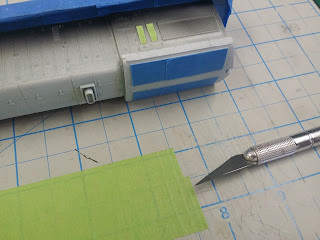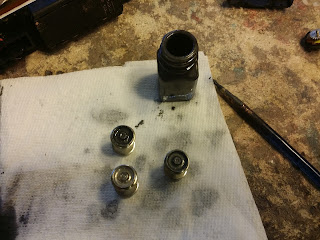Rebuilding old Bachmann U36B Part 2 Pancake Motor
Putting it back together
Let's finish up those wheels.... so cut the old traction tires off. I'm assuming you found traction tires on ebay and got a bag full, or you got some bullfrog snot. I'm not going to talk about bullfrog snot in this rebuild, but somewhere down the line we'll get to it. A word of warning - bullfrog snot is expensive and if it gets cold at all it is forever ruined. I spent about $30 for a tiny jar and it came already ruined and there is absolutely no returns. I'd like to get some to use on strange wheel sizes for old steam engines, but it's super expensive to risk ordering it.
Putting on the new tires is really easy. Once they're on, just run a small screw driver around the inside of them to make sure they're all flattened out.
But WAIT!!! I was going to do just a bit of weathering...sort of.
I put some of this liquid graphite into a small testors bottle and use it to paint the wheels so they look just a bit more real....it dries pretty fast and looks decent....
I'll polish the surfaces again when dry and then put the traction tires on...
OK, more wheels later.... for now let's take a look at those electrical connections.... 1 of them broke...
A little rosin flux and some solder and then a hit with the polishing wheel and we are back....
Let's start getting that motor back together...
Here it is cleaned and ready above and here below is where I skip a couple steps and put it back together...the mystery is in the gears - all the little gears are on the inside if you a looking at it this way:
Look how clean those gears are. Here they are from the top:
OK traction tires on and wheelsets back in:
HERE COMES THE PART WHERE WE DECIDE WHAT TYPE OF LUBRICANT GOES ON THESE GEARS...I use this bearing grease which is lithium, this one can has lasted me years and it looks like I've hardly used any. I've never had a problem with it, none of my gears have been attacked by it and it doesn't spread like oil does. One note is that is does take a bit of warming up sometimes if it's cold. You barely need any.
A tiny screwdriver lets me apply it:
And we got a spot on one wheel to clean, but otherwise everything looks good.
Now is the time to get real careful - we're going to put the brushes and springs back. If you drop a brush or spring, it will be gone forever, you'll never find it unless you no longer need it. So be extra careful here.
Put the brushes in and then do 1 spring at a time.
See this spring? If you drop it, it's gone. It is possible to buy springs this small from certain manufacturers like Templeman Co., but they still have to be trimmed, so let's try not to lose it:
Gently place the spring in its collar:
Now carefully position the frame and connect the lead:
How do you know if you have connected the correct lead to the correct post?
Here is the rule:
When a locomotive is on the track and you give it some power, the locomotive should move forward with the right hand side (aka engineer's side) on the right hand rail.
In other words, if your direction arrow is pointing right, your locomotive is facing right, then it moves right when you give it some power.
If your locomotive goes backwards, switch the 2 wires around. It can be more complicated, but don't make it more complicated.
Check out how that graphite paint worked, not bad and most important - easy to do.
An now a word about the sideframes...
I don't like these sideframes at all. These are really old and look terrible. Bachmann came out with much better sideframes later and the good news is that they fit. I do have some nicer ones, but what I'm hoping to get is the sideframes from the B23-7. I've tested them on these locomotives and they fit. The FB-2 sideframes are a big improvement, prototype or not, I like those FB-2 frames from the B23-7 for such a cheap rebuild. As of February 2017, the Bachmann parts catalog has some old Blomberg sideframes that are much nicer looking for under $5, but they will likely be gone in the near future.
Let's get it back together and test it. Since I know it's going to work, I'm going to put on some Bachmann E-Z Mate Over Shank couplers and guess (correctly) that they will line up with the height guage:
As you can see, I used the couple pocket and screw but added a tiny washer. If you don't have a tiny washer, make a simple plate with a hole in it to keep the coupler in place. Something that works is any thin plastic. You know how lots of things come in clear plastic blister packs? That stuff you use to make cheap windows for your buildings? Yes, that stuff will work.
Now lets check the height:
OK, the plastic frame is bent and the coupler is low. A bend with a pliers takes care of that problem. But what should you do if you don't have any over shank couplers? You can cut the coupler pockets off and mount them to the body instead. We'll do that to a TYCO locomotive do the road a bit.... now let's check again:
And the other side:
Time for the test track.....
In the next part we'll start looking at the body....























































